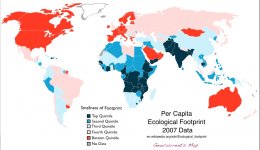Ecological footprint model
 The Happy Earth Index, discussed yesterday, relies on the ecological footprint to measure environmental sustainability. The footprint, widely regarded as “the world’s premier measure of humanity’s demand on nature, ” is defined as “the amount of biologically productive land and sea area needed to regenerate the resources a human population consumes and to absorb and render harmless the corresponding waste.” Calculations of country-level ecological footprints are substantially based on consumption figures, especially those of energy, food, and water. As all wealthy countries consume heavily, all have relatively large footprints. Some, however, are much larger than others. Rich countries that use energy efficiently, such as Japan, come in with lower figures than those that don’t, such as Canada. Poor countries consume little and thus generally have small footprints. Less developed countries with large prints typically have energy-intensive mining economies, Mongolia being the prime example.
The Happy Earth Index, discussed yesterday, relies on the ecological footprint to measure environmental sustainability. The footprint, widely regarded as “the world’s premier measure of humanity’s demand on nature, ” is defined as “the amount of biologically productive land and sea area needed to regenerate the resources a human population consumes and to absorb and render harmless the corresponding waste.” Calculations of country-level ecological footprints are substantially based on consumption figures, especially those of energy, food, and water. As all wealthy countries consume heavily, all have relatively large footprints. Some, however, are much larger than others. Rich countries that use energy efficiently, such as Japan, come in with lower figures than those that don’t, such as Canada. Poor countries consume little and thus generally have small footprints. Less developed countries with large prints typically have energy-intensive mining economies, Mongolia being the prime example.
The ecological footprint is a reasonable metric if used in the narrow sense of assessing the extent of land and sea needed to underwrite consumption. When it comes to the disposal of waste, however, the calculations become impossibly complex. How can does one, for example, determine the area required to “render harmless” the carbon dioxide pouring out of a coal-burning power plant, and then compare it precisely with the area needed to nullify radioactive waste generated by a nuclear power plant? And when used as an overarching measurement of environmental sustainability, the “footprint index” fails completely as it conceals many of the most severe forms of ecological degradation.
The environmental failings of the model are several-fold. Ironically, its signal flaw stems from its anthropocentric nature. The entire scheme is concerned only with the resources used by people. Other creatures, unless they are consumed, are of no account. A country could suffer an eco-catastrophe, seeing the extermination of all its large mammals and birds, and it would not register on the index. Wholesale deforestation, swamp drainage, and other forms of habitat destruction are hardly noted. The model is also static. The fact that the populations of Yemen and Pakistan will probably double within a half century, while that of Japan will likely decline, does not figure, nor does the break-neck industrialization of India and China.
blogging over 40 blogging coaching near me blogging wrap up blogging of photography blog over pmu blog outside blogging at medium blogging explained blogging quiz blog vs website in your blog or on your blog difference between blog and forum blogging with notion blogging through facebook blogging legally blogging basics blog in text citation apa blog post template google docs blog topics blog images blog xanga blogging software blog titles blogging of cars blog format blogging your way to the front row blogging platform before blog on instagram blog in hindi blog over geld blog niche ideas blog around the world trip blogging events blog towards data science blogging university blog yelp blogging goals blog designers near me blog xiaomi blog by jackie bavaro sign up blogging account bloggingpro theme blog feed format letters blog software blog editor blog out of date blogging theology youtube blogging is dying out blog xamarin